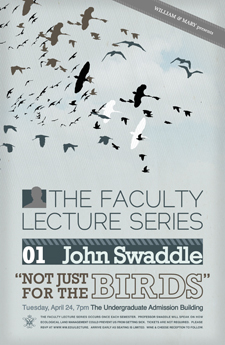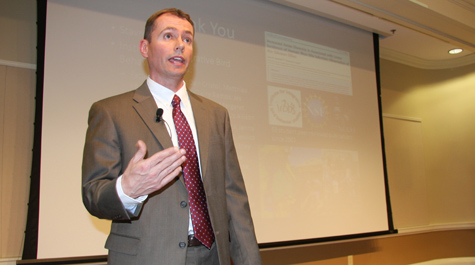John Swaddle kicks off Faculty Lecture Series
John Swaddle gave an upbeat, and occasionally hilarious, presentation on a potentially somber topic to kick off William & Mary’s Faculty Lecture Series.
Swaddle, professor of biology, spoke on “Not Just for the Birds: How ecological land management could prevent us from getting sick” to a full house April 24 in the Undergraduate Admission theatre. He explained, in layman’s terms, the cycle of vector-borne illnesses such as West Nile disease and outlined how they develop in wildlife hosts and are transferred to humans by vector pests—mosquitoes in the case of West Nile or ticks, in the case of Lyme disease. Swaddle used a set of visual aids and even pressed the William & Mary women’s rugby team into service. The team (which Swaddle coaches) passed rugby-ball “viruses” to demonstrate how vector-borne illnesses can “spill over” into the human population.
{{youtube:medium:left|99HHvb5Wprc, Highlights from the Faculty Lecture Series}}
“I thought the inaugural lecture was superb,” said Michael R. Halleran, William & Mary’s provost, after Swaddle’s lecture. “It was extremely well attended. John is an excellent lecturer. He obviously knows how to captivate an audience. It’s an extremely important issue and John made it understandable. It was perfect!”
Halleran introduced Swaddle and the series at large, noting that the Faculty Lecture Series will offer talks once each semester. The next two speakers in the series will be Professor of Religious Studies John Morreall in fall, 2012, and Professor of Geology Chuck Bailey in spring, 2013.
Swaddle’s presentation was drawn from research related to the 2002 West Nile outbreak among humans. He worked with Stavros Calos ’08, who Swaddle noted was a geology major “and did this just for fun.”
 West Nile, like many other vector-borne diseases, develops
in bird populations, then “spills over” into human populations. Swaddle
explained how a phenomenon called the “dilution effect” can limit the outbreaks
of West Nile and other vector-borne
diseases among humans. Basically, he explained, not all birds are equally
effective hosts of the disease. Plus, he said, the more effective hosts tend to
be the kind of birds that are most numerous in urban areas.
West Nile, like many other vector-borne diseases, develops
in bird populations, then “spills over” into human populations. Swaddle
explained how a phenomenon called the “dilution effect” can limit the outbreaks
of West Nile and other vector-borne
diseases among humans. Basically, he explained, not all birds are equally
effective hosts of the disease. Plus, he said, the more effective hosts tend to
be the kind of birds that are most numerous in urban areas.
Encouraging a more diverse avian population—even increasing the birds by one species—can dilute the population of effective hosts in an area, and consequently limit spillover of West Nile and similar diseases into the human population. Swaddle shared calculations that showed that adding a single new bird species in an area can result in a decline in spillover that amounts to 252 fewer humans contracting the disease.
Swaddle also explained how the increase in avian diversity is not just for the birds, but can save us all money. For example, during the 2002 West Nile outbreak, human cases in Louisiana cost an average of $84,000 each, he said.
“Armed with that knowledge, and as a biologist, I’m going to apply my best and my strongest econometric tool…” Swaddle said, reaching into his jacket pocket, “…the back of an envelope.”
He jotted down some figures, explaining that he was using the Louisiana figures and other numbers to calculate the savings that would have been realized by increasing avian biodiversity across the eastern United States. He turned the envelope around, showing the audience a round figure of $20 million. “Twenty-one point two million dollars, to be precise,” he said. He urged others to start to think about the economic benefits of biodiversity, as realized by the dilution effect.
Swaddle noted that his presentation is “just one tiny little lens” on the subject of preserving biodiversity. “This is one disease and one epidemic,” he said. “But this at least is a framework that people can use to think about the value of preserving any type of species that you might want to think about.”
He concluded his talk with a presentation of various land-use strategies to increase biodiversity. His recommendations ranged from keeping pet cats safely indoors, away from wildlife, and the use of more native plants in landscaping. Birds are more oriented to a three-dimensional environment, he explained and urged that planners begin think in three dimensions to attract birds by varying heights of both buildings and vegetation.
“If we concentrate on urban landscapes, that’s where we’ll have the most effect,” Swaddle said. “Because that’s where there’s the most disease and that’s where biodiversity is lowest already. So if we can increase biodiversity there, we’ll get a substantial increase in public health benefits.”















